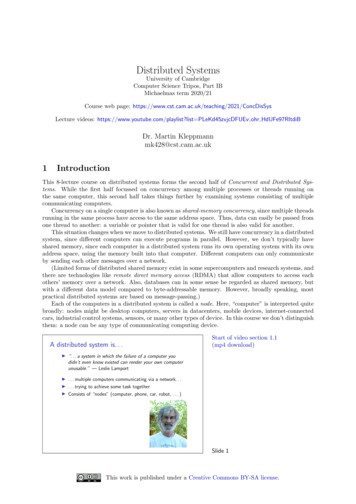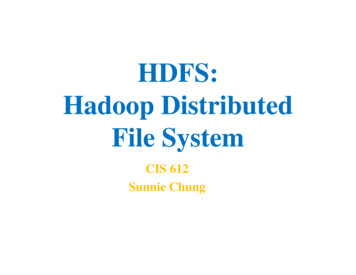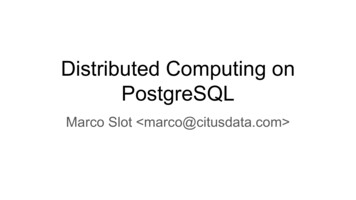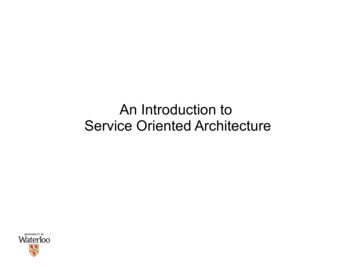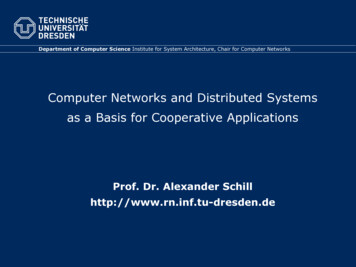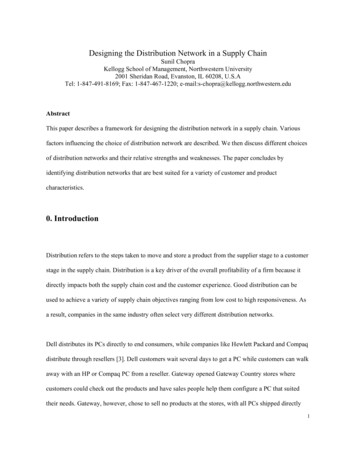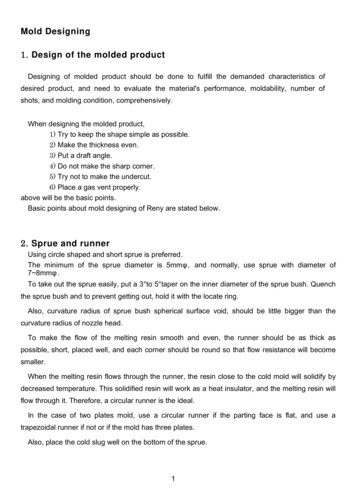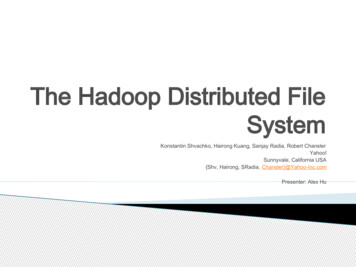
Transcription
DesigningDistributedSystemsPATTERNS AND PARADIGMS FOR SCALABLE, RELIABLE SERVICESBrendan Burns
Designing Distributed SystemsPatterns and Paradigms forScalable, Reliable ServicesBrendan BurnsBeijingBoston Farnham SebastopolTokyo
Designing Distributed Systemsby Brendan BurnsCopyright 2018 Brendan Burns. All rights reserved.Printed in the United States of America.Published by O’Reilly Media, Inc., 1005 Gravenstein Highway North, Sebastopol, CA 95472.O’Reilly books may be purchased for educational, business, or sales promotional use. Online editions arealso available for most titles (http://oreilly.com/safari). For more information, contact our corporate/insti‐tutional sales department: 800-998-9938 or corporate@oreilly.com.Editor: Angela RufinoProduction Editor: Colleen ColeCopyeditor: Gillian McGarveyProofreader: Christina EdwardsDecember 2017:Indexer: WordCo Indexing Services, Inc.Interior Designer: David FutatoCover Designer: Karen MontgomeryIllustrator: Rebecca DemarestFirst EditionRevision History for the First Edition2017-12-06:First ReleaseSee http://oreilly.com/catalog/errata.csp?isbn 9781491983645 for release details.The O’Reilly logo is a registered trademark of O’Reilly Media, Inc. Designing Distributed Systems, thecover image, and related trade dress are trademarks of O’Reilly Media, Inc.While the publisher and the author have used good faith efforts to ensure that the information andinstructions contained in this work are accurate, the publisher and the author disclaim all responsibilityfor errors or omissions, including without limitation responsibility for damages resulting from the use ofor reliance on this work. Use of the information and instructions contained in this work is at your ownrisk. If any code samples or other technology this work contains or describes is subject to open sourcelicenses or the intellectual property rights of others, it is your responsibility to ensure that your usethereof complies with such licenses and/or rights.978-1-492-03177-2[LSI]
Table of ContentsPreface. . . . . . . . . . . . . . . . . . . . . . . . . . . . . . . . . . . . . . . . . . . . . . . . . . . . . . . . . . . . . . . . . . . . . . . vii1. Introduction. . . . . . . . . . . . . . . . . . . . . . . . . . . . . . . . . . . . . . . . . . . . . . . . . . . . . . . . . . . . . . . . 1A Brief History of Systems DevelopmentA Brief History of Patterns in Software DevelopmentFormalization of Algorithmic ProgrammingPatterns for Object-Oriented ProgrammingThe Rise of Open Source SoftwareThe Value of Patterns, Practices, and ComponentsStanding on the Shoulders of GiantsA Shared Language for Discussing Our PracticeShared Components for Easy ReuseSummaryPart I. Single-Node PatternsMotivationsSummary1233344556782. The Sidecar Pattern. . . . . . . . . . . . . . . . . . . . . . . . . . . . . . . . . . . . . . . . . . . . . . . . . . . . . . . . 11An Example Sidecar: Adding HTTPS to a Legacy ServiceDynamic Configuration with SidecarsModular Application ContainersHands On: Deploying the topz ContainerBuilding a Simple PaaS with SidecarsDesigning Sidecars for Modularity and ReusabilityParameterized ContainersDefine Each Container’s API1112141415161717iii
Documenting Your ContainersSummary18193. Ambassadors. . . . . . . . . . . . . . . . . . . . . . . . . . . . . . . . . . . . . . . . . . . . . . . . . . . . . . . . . . . . . 21Using an Ambassador to Shard a ServiceHands On: Implementing a Sharded RedisUsing an Ambassador for Service BrokeringUsing an Ambassador to Do Experimentation or Request SplittingHands On: Implementing 10% Experiments22232526274. Adapters. . . . . . . . . . . . . . . . . . . . . . . . . . . . . . . . . . . . . . . . . . . . . . . . . . . . . . . . . . . . . . . . . 31MonitoringHands On: Using Prometheus for MonitoringLoggingHands On: Normalizing Different Logging Formats with FluentdAdding a Health MonitorHands On: Adding Rich Health Monitoring for MySQLPart II.Serving PatternsIntroduction to Microservices323334353637415. Replicated Load-Balanced Services. . . . . . . . . . . . . . . . . . . . . . . . . . . . . . . . . . . . . . . . . . 45Stateless ServicesReadiness Probes for Load BalancingHands On: Creating a Replicated Service in KubernetesSession Tracked ServicesApplication-Layer Replicated ServicesIntroducing a Caching LayerDeploying Your CacheHands On: Deploying the Caching LayerExpanding the Caching LayerRate Limiting and Denial-of-Service DefenseSSL TerminationHands On: Deploying nginx and SSL TerminationSummary454647484949505153545455576. Sharded Services. . . . . . . . . . . . . . . . . . . . . . . . . . . . . . . . . . . . . . . . . . . . . . . . . . . . . . . . . . 59Sharded CachingWhy You Might Need a Sharded CacheThe Role of the Cache in System PerformanceReplicated, Sharded Cachesiv Table of Contents59606162
Hands On: Deploying an Ambassador and Memcache for a Sharded CacheAn Examination of Sharding FunctionsSelecting a KeyConsistent Hashing FunctionsHands On: Building a Consistent HTTP Sharding ProxySharded, Replicated ServingHot Sharding Systems636667686970707. Scatter/Gather. . . . . . . . . . . . . . . . . . . . . . . . . . . . . . . . . . . . . . . . . . . . . . . . . . . . . . . . . . . . 73Scatter/Gather with Root DistributionHands On: Distributed Document SearchScatter/Gather with Leaf ShardingHands On: Sharded Document SearchChoosing the Right Number of LeavesScaling Scatter/Gather for Reliability and Scale7475767778798. Functions and Event-Driven Processing. . . . . . . . . . . . . . . . . . . . . . . . . . . . . . . . . . . . . . . 81Determining When FaaS Makes SenseThe Benefits of FaaSThe Challenges of FaaSThe Need for Background ProcessingThe Need to Hold Data in MemoryThe Costs of Sustained Request-Based ProcessingPatterns for FaaSThe Decorator Pattern: Request or Response TransformationHands On: Adding Request Defaulting Prior to Request ProcessingHandling EventsHands On: Implementing Two-Factor AuthenticationEvent-Based PipelinesHands On: Implementing a Pipeline for New-User Signup828282838384848586878789899. Ownership Election. . . . . . . . . . . . . . . . . . . . . . . . . . . . . . . . . . . . . . . . . . . . . . . . . . . . . . . . 93Determining If You Even Need Master ElectionThe Basics of Master ElectionHands On: Deploying etcdImplementing LocksHands On: Implementing Locks in etcdImplementing OwnershipHands On: Implementing Leases in etcdHandling Concurrent Data Manipulation94959798100101102103Table of Contents v
Part III. Batch Computational Patterns10. Work Queue Systems. . . . . . . . . . . . . . . . . . . . . . . . . . . . . . . . . . . . . . . . . . . . . . . . . . . . . 109A Generic Work Queue SystemThe Source Container InterfaceThe Worker Container InterfaceThe Shared Work Queue InfrastructureHands On: Implementing a Video ThumbnailerDynamic Scaling of the WorkersThe Multi-Worker Pattern10911011211311511711811. Event-Driven Batch Processing. . . . . . . . . . . . . . . . . . . . . . . . . . . . . . . . . . . . . . . . . . . . . 121Patterns of Event-Driven ProcessingCopierFilterSplitterSharderMergerHands On: Building an Event-Driven Flow for New User Sign-UpPublisher/Subscriber InfrastructureHands On: Deploying Kafka12212212312412512712812913012. Coordinated Batch Processing. . . . . . . . . . . . . . . . . . . . . . . . . . . . . . . . . . . . . . . . . . . . . . 133Join (or Barrier Synchronization)ReduceHands On: CountSumHistogramHands On: An Image Tagging and Processing Pipeline13413513613713713813. Conclusion: A New Beginning?. . . . . . . . . . . . . . . . . . . . . . . . . . . . . . . . . . . . . . . . . . . . . 143Index. . . . . . . . . . . . . . . . . . . . . . . . . . . . . . . . . . . . . . . . . . . . . . . . . . . . . . . . . . . . . . . . . . . . . . . 145vi Table of Contents
PrefaceWho Should Read This BookAt this point, nearly every developer is a developer or consumer (or both) of dis‐tributed systems. Even relatively simple mobile applications are backed with cloudAPIs so that their data can be present on whatever device the customer happens to beusing. Whether you are new to developing distributed systems or an expert with scarson your hands to prove it, the patterns and components described in this book cantransform your development of distributed systems from art to science. Reusablecomponents and patterns for distributed systems will enable you to focus on the coredetails of your application. This book will help any developer become better, faster,and more efficient at building distributed systems.Why I Wrote This BookThroughout my career as a developer of a variety of software systems from websearch to the cloud, I have built a large number of scalable, reliable distributed sys‐tems. Each of these systems was, by and large, built from scratch. In general, this istrue of all distributed applications. Despite having many of the same concepts andeven at times nearly identical logic, the ability to apply patterns or reuse componentsis often very, very challenging. This forced me to waste time reimplementing systems,and each system ended up less polished than it might have otherwise been.The recent introduction of containers and container orchestrators fundamentallychanged the landscape of distributed system development. Suddenly we have anobject and interface for expressing core distributed system patterns and buildingreusable containerized components. I wrote this book to bring together all of thepractitioners of distributed systems, giving us a shared language and common stan‐dard library so that we can all build better systems more quickly.vii
The World of Distributed Systems TodayOnce upon a time, people wrote programs that ran on one machine and were alsoaccessed from that machine. The world has changed. Now, nearly every application isa distributed system running on multiple machines and accessed by multiple usersfrom all over the world. Despite their prevalence, the design and development ofthese systems is often a black art practiced by a select group of wizards. But as witheverything in technology, the world of distributed systems is advancing, regularizing,and abstracting. In this book I capture a collection of repeatable, generic patterns thatcan make the development of reliable distributed systems more approachable andefficient. The adoption of patterns and reusable components frees developers fromreimplementing the same systems over and over again. This time is then freed tofocus on building the core application itself.Navigating This BookThis book is organized into a 4 parts as follows:Chapter 1, IntroductionIntroduces distributed systems and explains why patterns and reusable compo‐nents can make such a difference in the rapid development of reliable distributedsystems.Part I, Single-Node PatternsChapters 2 through 4 discuss reusable patterns and components that occur onindividual nodes within a distributed system. It covers the side-car, adapter, andambassador single-node patterns.Part II, Serving PatternsChapters 8 and 9 cover multi-node distributed patterns for long-running servingsystems like web applications. Patterns for replicating, scaling, and master elec‐tion are discussed.Part III, Batch Computational PatternsChapters 10 through 12 cover distributed system patterns for large-scale batchdata processing covering work queues, event-based processing, and coordinatedworkflows.If you are an experienced distributed systems engineer, you can likely skip the firstcouple of chapters, though you may want to skim them to understand how we expectthese patterns to be applied and why we think the general notion of distributed sys‐tem patterns is so important.Everyone will likely find utility in the single-node patterns as they are the mostgeneric and most reusable patterns in the book.viii Preface
Depending on your goals and the systems you are interested in developing, you canchoose to focus on either large-scale big data patterns, or patterns for long-runningservers (or both). The two parts are largely independent from each other and can beread in any order.Likewise, if you have extensive distributed system experience, you may find that someof the early patterns chapters (e.g., Part II on naming, discovery, and load balancing)are redundant with what you already know, so feel free to skim through to gain thehigh-level insights—but don’t forget to look at all of the pretty pictures!Conventions Used in This BookThe following typographical conventions are used in this book:ItalicIndicates new terms, URLs, email addresses, filenames, and file extensions.Constant widthUsed for program listings, as well as within paragraphs to refer to program ele‐ments such as variable or function names, databases, data types, environmentvariables, statements, and keywords.Constant width boldShows commands or other text that should be typed literally by the user.Constant width italicShows text that should be replaced with user-supplied values or by values deter‐mined by context.This icon signifies a tip, suggestion, or general note.This icon indicates a warning or caution.Online ResourcesThough this book describes generally applicable distributed system patterns, itexpects that readers are familiar with containers and container orchestration systems.Preface ix
If you don’t have a lot of pre-existing knowledge about these things, we recommendthe following resources: https://docker.io https://kubernetes.io https://dcos.ioUsing Code ExamplesSupplemental material (code examples, exercises, etc.) is available for download ibuted-systems.This book is here to help you get your job done. In general, if example code is offeredwith this book, you may use it in your programs and documentation. You do notneed to contact us for permission unless you’re reproducing a significant portion ofthe code. For example, writing a program that uses several chunks of code from thisbook does not require permission. Selling or distributing a CD-ROM of examplesfrom O’Reilly books does require permission. Answering a question by citing thisbook and quoting example code does not require permission. Incorporating a signifi‐cant amount of example code from this book into your product’s documentation doesrequire permission.We appreciate, but do not require, attribution. An attribution usually includes thetitle, author, publisher, and ISBN. For example: “Designing Distributed Systems byBrendan Burns (O’Reilly). Copyright 2018 Brendan Burns, 978-1-491-98364-5.”If you feel your use of code examples falls outside fair use or the permission givenabove, feel free to contact us at permissions@oreilly.com.O’Reilly SafariSafari (formerly Safari Books Online) is a membership-basedtraining and reference platform for enterprise, government,educators, and individuals.Members have access to thousands of books, training videos, Learning Paths, interac‐tive tutorials, and curated playlists from over 250 publishers, including O’ReillyMedia, Harvard Business Review, Prentice Hall Professional, Addison-Wesley Profes‐sional, Microsoft Press, Sams, Que, Peachpit Press, Adobe, Focal Press, Cisco Press,John Wiley & Sons, Syngress, Morgan Kaufmann, IBM Redbooks, Packt, AdobePress, FT Press, Apress, Manning, New Riders, McGraw-Hill, Jones & Bartlett, andCourse Technology, among others.x Preface
For more information, please visit http://oreilly.com/safari.How to Contact UsPlease address comments and questions concerning this book to the publisher:O’Reilly Media, Inc.1005 Gravenstein Highway NorthSebastopol, CA 95472800-998-9938 (in the United States or Canada)707-829-0515 (international or local)707-829-0104 (fax)We have a web page for this book, where we list errata, examples, and any additionalinformation. You can access this page at http://bit.ly/designing-distributed-systems.To comment or ask technical questions about this book, send email to bookques‐tions@oreilly.com.For more information about our books, courses, conferences, and news, see our web‐site at http://www.oreilly.com.Find us on Facebook: http://facebook.com/oreillyFollow us on Twitter: http://twitter.com/oreillymediaWatch us on YouTube: I’d like to thank my wife Robin and my children for everything they do to keep mehappy and sane. To all of the people along the way who took the time to help me learnall of these things, many thanks! Also thanks to my parents for that first SE/30.Preface xi
CHAPTER 1IntroductionToday’s world of always-on applications and APIs have availability and reliabilityrequirements that would have been required of only a handful of mission criticalservices around the globe only a few decades ago. Likewise, the potential for rapid,viral growth of a service means that every application has to be built to scale nearlyinstantly in response to user demand. These constraints and requirements mean thatalmost every application that is built—whether it is a consumer mobile app or a back‐end payments application—needs to be a distributed system.But building distributed systems is challenging. Often, they are one-off bespoke solu‐tions. In this way, distributed system development bears a striking resemblance to theworld of software development prior to the development of modern object-orientedprogramming languages. Fortunately, as with the development of object-oriented lan‐guages, there have been technological advances that have dramatically reduced thechallenges of building distributed systems. In this case, it is the rising popularity ofcontainers and container orchestrators. As with the concept of objects within objectoriented programming, these containerized building blocks are the basis for thedevelopment of reusable components and patterns that dramatically simplify andmake accessible the practices of building reliable distributed systems. In the followingintroduction, we give a brief history of the developments that have led to where weare today.A Brief History of Systems DevelopmentIn the beginning, there were machines built for specific purposes, such as calculatingartillery tables or the tides, breaking codes, or other precise, complicated but rotemathematical applications. Eventually these purpose-built machines evolved intogeneral-purpose programmable machines. And eventually they evolved from running1
one program at a time to running multiple programs on a single machine via timesharing operating systems, but these machines were still disjoint from each other.Gradually, machines came to be networked together, and client-server architectureswere born so that a relatively low-powered machine on someone’s desk could be usedto harness the greater power of a mainframe in another room or building. While thissort of client-server programming was somewhat more complicated than writing aprogram for a single machine, it was still fairly straightforward to understand. Theclient(s) made requests; the server(s) serviced those requests.In the early 2000s, the rise of the internet and large-scale datacenters consisting ofthousands of relatively low-cost commodity computers networked together gave riseto the widespread development of distributed systems. Unlike client-server architec‐tures, distributed system applications are made up of multiple different applicationsrunning on different machines, or many replicas running across different machines,all communicating together to implement a system like web-search or a retail salesplatform.Because of their distributed nature, when structured properly, distributed systems areinherently more reliable. And when architected correctly, they can lead to much morescalable organizational models for the teams of software engineers that built thesesystems. Unfortunately, these advantages come at a cost. These distributed systemscan be significantly more complicated to design, build, and debug correctly. The engi‐neering skills needed to build a reliable distributed system are significantly higherthan those needed to build single-machine applications like mobile or web frontends.Regardless, the need for reliable distributed systems only continues to grow. Thusthere is a corresponding need for the tools, patterns, and practices for building them.Fortunately, technology has also increased the ease with which you can build dis‐tributed systems. Containers, container images, and container orchestrators have allbecome popular in recent years because they are the foundation and building blocksfor reliable distributed systems. Using containers and container orchestration as afoundation, we can establish a collection of patterns and reusable components. Thesepatterns and components are a toolkit that we can use to build our systems more reli‐ably and efficiently.A Brief History of Patterns in Software DevelopmentThis is not the first time such a transformation has occurred in the software industry.For a better context on how patterns, practices, and reusable components have previ‐ously reshaped systems development, it is helpful to look at past moments when simi‐lar transformations have taken place.2 Chapter 1: Introduction
Formalization of Algorithmic ProgrammingThough people had been programming for more than a decade before its publicationin 1962, Donald Knuth’s collection, The Art of Computer Programming (AddisonWesley Professional), marks an important chapter in the development of computerscience. In particular, the books contain algorithms not designed for any specificcomputer, but rather to educate the reader on the algorithms themselves. These algo‐rithms then could be adapted to the specific architecture of the machine being usedor the specific problem that the reader was solving. This formalization was importantbecause it provided users with a shared toolkit for building their programs, but alsobecause it showed that there was a general-purpose concept that programmers shouldlearn and then subsequently apply in a variety of different contexts. The algorithmsthemselves, independent of any specific problem to solve, were worth understandingfor their own sake.Patterns for Object-Oriented ProgrammingKnuth’s books represent an important landmark in the thinking about computer pro‐gramming, and algorithms represent an important component in the development ofcomputer programming. However, as the complexity of programs grew, and thenumber of people writing a single program grew from the single digits to the doubledigits and eventually to the thousands, it became clear that procedural programminglanguages and algorithms were insufficient for the tasks of modern-day program‐ming. These changes in computer programming led to the development of objectoriented programming languages, which elevated data, reusability, and extensibilityto peers of the algorithm in the development of computer programs.In response to these changes to computer programming, there were changes to thepatterns and practices for programming as well. Throughout the early to mid-1990s,there was an explosion of books on patterns for object-oriented programming. Themost famous of these is the “gang of four” book, Design Patterns: Elements of ReusableObject-Oriented Programming by Erich Gamma et al. (Addison-Wesley Professional).Design Patterns gave a common language and framework to the task of program‐ming. It described a series of interface-based patterns that could be reused in a varietyof contexts. Because of advances in object-oriented programming and specificallyinterfaces, these patterns could also be implemented as generic reusable libraries.These libraries could be written once by a community of developers and reusedrepeatedly, saving time and improving reliability.The Rise of Open Source SoftwareThough the concept of developers sharing source code has been around nearly sincethe beginning of computing, and formal free software organizations have been inexistence since the mid-1980s, the very late 1990s and the 2000s saw a dramaticA Brief History of Patterns in Software Development 3
increase in the development and distribution of open source software. Though opensource is only tangentially related to the development of patterns for distributed sys‐tems, it is important in the sense that it was through the open source communitiesthat it became increasingly clear that software development in general and distributedsystems development in particular are community endeavors. It is important to notethat all of the container technology that forms the foundation of the patternsdescribed in this book has been developed and released as open source software. Thevalue of patterns for both describing and improving the practice of distributed devel‐opment is especially clear when you look at it from this community perspective.What is a pattern for a distributed system? There are plenty ofinstructions out there that will tell you how to install specific dis‐tributed systems (such as a NoSQL database). Likewise, there arerecipes for a specific collection of systems (like a MEAN stack). Butwhen I speak of patterns, I’m referring to general blueprints fororganizing distributed systems, without mandating any specifictechnology or application choices. The purpose of a pattern is toprovide general advice or structure to guide your design. The hopeis that such patterns will guide your thinking and also be generallyapplicable to a wide variety of applications and environments.The Value of Patterns, Practices, and ComponentsBefore spending any of your valuable time reading about a series of patterns that Iclaim will improve your development practices, teach you new skills, and—let’s face it—change your life, it’s reasonable to ask: “Why?” What is it about the design patternsand practices that can change the way that we design and build software? In this sec‐tion, I’ll lay out the reasons I think this is an important topic, and hopefully convinceyou to stick with me for the rest of the book.Standing on the Shoulders of GiantsAs a starting point, the value that patterns for distributed systems offer is the oppor‐tunity to figuratively stand on the shoulders of giants. It’s rarely the case that theproblems we solve or the systems we build are truly unique. Ultimately, the combina‐tion of pieces that we put together and the overall business model that the softwareenables may be something that the world has never seen before. But the way the sys‐tem is built and the problems it encounters as it aspires to be reliable, agile, and scala‐ble are not new.This, then, is the first value of patterns: they allow us to learn from the mistakes ofothers. Perhaps you have never built a distributed system before, or perhaps you havenever built this type of distributed system. Rather than hoping that a colleague hassome experience in this area or learning by making the same mistakes that others4 Chapter 1: Introduction
have already made, you can turn to patterns as your guide. Learning about patternsfor distributed system development is the same as learning about any other best prac‐tice in computer programming. It accelerates your ability to build software withoutrequiring that you have direct experience with the systems, mistakes, and firsthandlearning that led to the codification of the pattern in the first place.A Shared Language for Discussing Our PracticeLearning about and accelerating our understanding of distributed systems is only thefirst value of having a shared set of patterns. Patterns have value even for experienceddistributed system developers who already understand them well. Patterns provide ashared vocabulary that enables us to understand each other quickly. This understand‐ing forms the basis for knowledge sharing and further learning.To better understand this, imagine that we both are using the same object to buildour house. I call that object a “Foo” while you call that object a “Bar.” How long willwe spend arguing about the value of a Foo versus that of a Bar, or trying to explainthe differing properties of Foo and Bar until we figure out that we’re speaking aboutthe same object? Only once we determine that Foo and Bar are the same can we trulystart learning from each other’s experience.Without a common vocabulary, we waste time in arguments of “violent agreement”or in explaining concepts that others understand but know by another name. Conse‐quently, another significant value of patterns is to provide a common set of namesand definitions so that we don’t waste time worrying about naming, and instead getright down to discussing the details and implementation of the core concepts.I have seen this happen in my short time working on containers. Along the way, thenotion of a sidecar container (described in Chapter 2 of this book) took hold withinthe container community. Because of this, we no longer have to spend time definingwhat it means to be a sidecar and can instead jump immediately to how the conceptcan be used to solve a particular problem. “If we just use a sidecar” “Yeah, and Iknow just the container we can use for that.” This example leads to the third value ofpatterns: the construction of reusable components.Shared Components for Easy ReuseBeyond enabling people to learn from others and providing a shared vocabulary fordiscussing the art of building systems, patterns provide another important tool forcomputer programming: the ability to identify common components that can beimplemented once.If we had to create all of the code that our programs use ourselves, we would neverget done. Indeed, we would barely get started. Today, every system ever writtenstands on the shoulders of thousands if not hundreds of thousands of years of humanThe Value of Patterns, Practices, and Components 5
effort. Code for operating systems, printer drivers, distributed databases, containerruntimes, and container orchestrators—indeed, the entirety of applications that webuild today are
from all over the world. Despite their prevalence, the design and development of these systems is often a black art practiced by a select group of wizards. But as with everything in technology, the world of distributed systems is advancing, regularizing, and abstracting. In this book I

